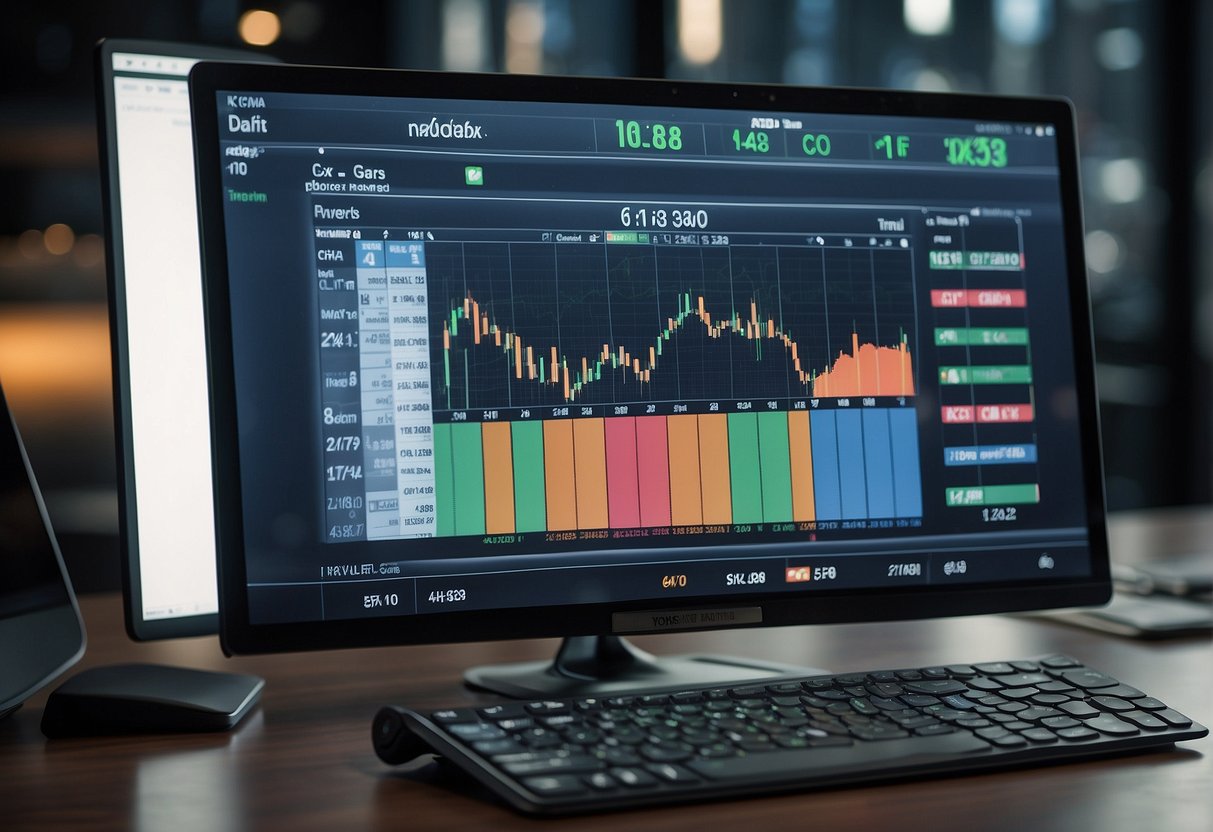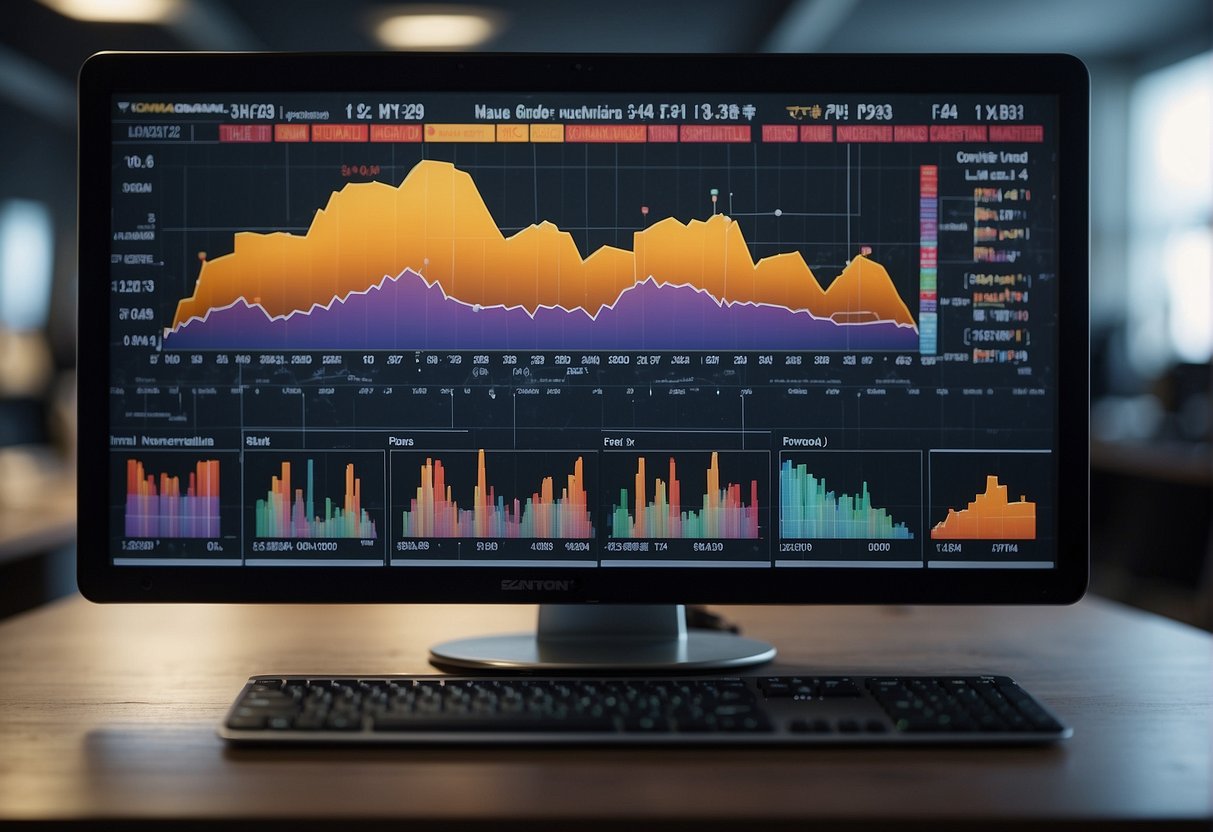Investing in financial markets is a complex endeavor that requires careful planning and consideration of various factors. One such factor is implementing a market timing strategy, which aims to capitalize on fluctuating market conditions by making well-timed investment decisions. While market timing has the potential to generate higher returns, it is crucial for investors to thoroughly understand the key factors involved before taking this approach.

Among these factors, investors must comprehend the impact of economic indicators on market timing, use suitable trading tactics that align with their investment goals and risk management strategies, and stay up-to-date with changes in market cycles and sentiment. Furthermore, market timing practitioners need to consider technology’s role and evaluate the transaction costs and tax implications that may affect their strategy. Ultimately, determining the effectiveness of market timing compared to other methods, such as buy-and-hold and incorporating diversification across asset classes, is also essential before implementation.
Key Takeaways
- Market timing requires understanding economic indicators, investment goals, and risk management strategies.
- Assessing technology, transaction costs, and tax implications is vital for successful market timing.
- Diversification and comparing market timing to other strategies, such as buy-and-hold, are crucial factors.
Understanding Market Timing
Market Timing Strategies
Market timing is an investment strategy that involves predicting the future movements of financial markets to maximize profits or minimize losses. Investors use various market timing strategies, such as momentum investing, sector rotation, and asset allocation. Understanding the risks and potential rewards associated with each strategy is essential before implementing them in your investment approach.
- Momentum investing involves buying securities that have been performing well and selling those that perform poorly.
- Sector rotation: focuses on investing in sectors expected to outperform others during a particular market cycle.
- Asset allocation entails diversifying your investment portfolio across different asset classes (e.g., stocks, bonds, and cash) based on your risk tolerance and investment objectives.
Market Volatility and Price Movements
To implement a successful market timing strategy, investors must know about market volatility and price movements. Market volatility refers to fluctuations in asset prices, which factors like economic data, corporate earnings, and geopolitical events can influence. Understanding these factors allows investors to make more informed decisions about entering or exiting their positions.
Some critical concepts related to market volatility include:
- Bear market: A period in which financial markets experience prolonged downward trends, typically marked by a decline of 20% or more in asset prices.
- Bull market: A period of consistently rising asset prices driven by investor optimism and confidence in future growth.
- Correction: A temporary reversal in market trends typically involves a drop of at least 10% in asset prices.
Fundamental vs. Technical Analysis
Regarding market timing strategies, two main approaches can help investors predict future price movements: fundamental and technical analysis. Each method has its benefits and drawbacks, with some investors even combining the two for a more comprehensive analysis.
Fundamental analysis focuses on the intrinsic value of an asset by examining factors such as company earnings, industry trends, and economic data. This method aims to identify undervalued or overvalued investments based on their fundamental strengths or weaknesses.
Technical analysis, on the other hand, relies on historical data and chart patterns to predict future price movements. Technical analysts use tools like moving averages and trendlines to identify potential market trends and buy or sell signals.
In conclusion, understanding market timing requires a thorough knowledge of the strategies, market volatility, and the differences between fundamental and technical analysis. Investors can improve their chances of successfully navigating the financial markets by carefully considering these factors.
Impact of Economic Indicators
Analyzing Economic Data
When implementing a market timing strategy, it is essential to consider the impact of economic indicators. These indicators provide valuable insights into the economy’s health, which can help investors make informed decisions. Some key financial indicators to monitor include GDP, CPI, unemployment rate, interest rates, and stock market indexes.
Investors should stay up-to-date with the latest economic data releases to make accurate predictions on market trends. Investopedia suggests understanding major economic indicators can help investors anticipate the economy’s direction and make better investment decisions.
Inflation and Unemployment Rates
Inflation and unemployment rates are two crucial economic indicators that investors should monitor. Inflation is the rate at which prices increase over time, affecting currency’s purchasing power. Investors need to monitor inflation, as it can impact their actual returns.
According to FINRA, the unemployment rate measures the percentage of the jobless labor force and actively seeking employment. A high unemployment rate is generally considered a sign of economic weakness, which can negatively affect stock prices. On the other hand, a low unemployment rate might indicate a healthy economy and can increase stock prices.
GDP Growth and Market Trends
Gross Domestic Product (GDP) measures the total value of goods and services produced within a country during a specific time period. Real GDP growth, adjusted for inflation, is considered a key indicator of economic health. Cheerful optimism indicates a strong economy and can lead to bullish market trends, while negative GDP growth might signify a weak economy and bearish market trends.
Monitoring GDP growth can help investors make informed decisions about the timing of their investments. By understanding the relationship between economic indicators like GDP and market trends, investors can better anticipate changes in the market and optimize their investment strategies accordingly.
Investment Goals and Risk Management

Determining Risk Tolerance
An investor should assess their risk tolerance before implementing a market timing strategy. Risk tolerance refers to an individual’s willingness and ability to withstand fluctuations in the value of their investments. Factors influencing risk tolerance may include age, financial stability, and investment goals. A thorough understanding of risk tolerance helps investors decide which market timing strategies suit them best.
To determine their risk tolerance, investors should ask themselves:
- How much loss can I endure before I need to withdraw my investment?
- What is the likelihood of achieving my financial goals with my current investments?
- How comfortable am I with the risk associated with market fluctuations?
An investor with a low-risk tolerance might opt for a conservative investment approach, such as diversifying their portfolio across different asset classes. On the other hand, an investor with high-risk tolerance might be comfortable with more aggressive market timing strategies, such as short-term trading, to potentially achieve higher returns.
Setting Realistic Expectations for Returns
After assessing risk tolerance, setting realistic expectations for returns is essential. Overly optimistic expectations are often a recipe for disappointment and can lead to impulsive market decision-making.
Setting realistic expectations can involve:
- Historical Performance: Analyzing the previous performance of various market timing strategies and comparing them against one’s investment goals.
- Risk and Return Ratio: Understanding the relationship between risk and potential return. Generally, higher-risk investments offer the potential for greater returns but also come with increased volatility.
- Time Horizon: Factoring in the length of the investment period. A longer investment horizon may allow for potential recovery from market downturns, while a shorter horizon might require a more conservative approach to market timing.
In conclusion, before implementing a market timing strategy, investors should carefully consider their risk tolerance and set realistic expectations for returns. Thoroughly understanding these factors can help investors make well-informed decisions and confidently navigate the market’s ups and downs.
Footnotes
- (https://www.moneyunder30.com/investment-risk-management/)
- (https://thestrategystory.com/blog/investment-strategy-explained-with-types-and-examples/)
- (https://www.financestrategists.com/wealth-management/investment-management/investment-selection/)
- (https://www.financestrategists.com/wealth-management/investment-risk/)
- (https://www.investopedia.com/terms/i/investmentstrategy.asp)
Analyzing Market Cycles and Sentiment
Sentiment Analysis Techniques
Sentiment analysis is a vital technique for understanding market cycles, as it helps investors gauge the fluctuating emotions of market participants. These emotions influence their perceptions of financial markets and play a crucial role in shaping market trends. One way to integrate sentiment analysis into investment strategies is by monitoring social media sentiment or using surveys and sentiment analysis tools. By understanding sentiment cycles, investors can anticipate and respond to shifts in market cycles effectively.
Utilizing Momentum Indicators
Momentum indicators are another critical factor to consider in market timing strategies. These indicators help traders and investors determine the strength and direction of a trend, making them essential tools for trend-following techniques. Some commonly used momentum indicators include the moving average convergence divergence (MACD), relative strength index (RSI), and the rate of change (ROC) indicator.
Here is a brief overview of these three momentum indicators:
- MACD: Measures the difference between two moving averages to identify trend direction and potential reversals
- RSI: Compares the magnitude of recent gains and losses to determine overbought or oversold conditions
- ROC: Calculates the percentage change in price over a specified period to identify emerging trends and potential reversals
Utilizing these momentum indicators with sentiment analysis can provide valuable insights into market cycles and help investors make more informed decisions when implementing a market timing strategy. By accurately identifying critical aspects of market cycles, such as the accumulation, markup, distribution, and markdown phases, investors can improve their decision-making process and increase their chances of success in the market.
Strategic Trading Tactics

Swing Trading and Trend Lines
Swing trading is a popular approach that involves identifying short-term price movements to enter and exit trades. This trading style emphasizes capturing gains in a stock or financial instrument within an overnight hold to several weeks. A key aspect of swing trading is recognizing and utilizing trend lines. A trend line is a diagonal line drawn on a chart to help traders identify the market’s direction.
In an uptrending market, Draw a trend line by connecting the higher lows of the price movements. On the other hand, a trend line in a down-trending market can be drawn by connecting the lower highs of the price movements. Proper use of trend lines helps traders to:
- Identify potential entry and exit points
- Set stop-loss levels to manage risk exposure
- Monitor market reversals and support/resistance levels
- Confirm market direction
Understanding Long and Short Positions
Both long and short positions play crucial roles when implementing a market timing strategy. A long position involves buying a financial instrument, such as a stock or a commodity, expecting its value to increase over time. Investors adopting a long position can benefit from capital appreciation and dividend income (in the case of stocks). Long trades are typically executed when the market is in an uptrend or when a specific asset exhibits upward solid momentum.
On the other hand, a short position involves selling an asset with the expectation that its value will decline, allowing the investor to repurchase it at a lower price later on. This strategy capitalizes on falling prices and is executed when the market is in a downtrend or when a specific asset displays solid downward momentum.
Key factors to consider before implementing a market timing strategy include:
- Time horizon: Align your trades with your investment goals and time horizon. Swing trading may be more suitable for shorter time horizons, whereas long-term positions could be better suited for investors with more extended time frames.
- Risk tolerance: Establish a clear risk management plan, including appropriate stop-loss levels and position sizing.
- Market analysis: Monitor market trends, economic indicators, and relevant news events to make informed trading decisions.
- Diversification: Maintain a diversified portfolio to help minimize risk and enhance potential returns.
By considering these factors and adapting appropriate strategic trading tactics, such as swing trading, trend lines, and understanding long and short positions, investors can more effectively execute their market timing strategies.
The Role of Technology in Market Timing

As the financial markets evolve, technology plays a pivotal role in implementing market timing strategies. In this section, we will highlight the impact of technology on market timing, focusing on Algorithmic Trading Platforms and Advancements in Analysis Tools.
Algorithmic Trading Platforms
A significant development in market timing is the use of algorithmic trading platforms. These platforms employ sophisticated algorithms to execute trades at high speed and efficiency, capitalizing on small price fluctuations in the market. Designed to maximize profits and minimize human errors, algorithmic trading allows investors to remain agile and competitive in the ever-changing market landscape.
Some key features of algorithmic trading platforms include:
- Automated trade execution: Trades are executed automatically based on predetermined rules and strategies, eliminating the need for constant manual intervention.
- Low-latency: These platforms boast high-speed trade executions, allowing investors to respond faster to market changes and take advantage of trading opportunities.
- Risk management: Built-in features help protect investors from potential losses and minimize the impact of unfavorable market conditions.
Advancements in Analysis Tools
Aside from algorithmic trading platforms, there has been significant progress in developing analysis tools. These technologies simplify complex market data, enabling investors to make more informed decisions when implementing market timing strategies. Some notable advancements in analysis tools include:
- Technical analysis software: These tools offer various indicators and real-time charting capabilities, enabling investors to analyze past price movements and identify potential trends.
- Machine learning algorithms: Incorporating machine learning techniques into market analysis tools allows for more accurate predictions and identification of patterns.
- Big data analytics: Harnessing big data and processing large volumes of market information facilitates better decision-making by providing deeper insights into market trends and possible future scenarios.
In summary, emerging technologies, such as algorithmic trading platforms and advanced analysis tools, have transformed how investors approach market timing strategies. These innovations provide faster and more precise decisions, aiding investors in staying disciplined and adaptable in the face of market fluctuations. However, it remains crucial for investors to maintain a strong foundation in market knowledge, discipline, and risk management practices when employing these technologies.
Transaction Costs and Tax Implications
Calculating Transaction Costs
When implementing a market timing strategy, it is crucial to consider transaction costs. These costs occur whenever a financial instrument, such as a stock or a bond, is bought or sold. The main components of transaction costs include brokerage commissions, bid-ask spreads, and market impact.
To illustrate the impact of transaction costs, let’s consider the following example:
| Stock | Buy Price | Sell Price | Commission | Bid-Ask Spread |
|---|---|---|---|---|
| ABC | $50.00 | $55.00 | $5 | $0.05 |
In the above table, the trader buys 100 shares of stock ABC for $50 per share and later sells them at $55 per share. The commission for each transaction is $5, and the bid-ask spread is $0.05. Here’s a calculation of the total transaction cost:
Total transaction cost = (Commission * 2) + Bid-Ask spread * 100 = ($5 * 2) + ($0.05 * 100) = $15
It is essential to factor in these transaction costs when creating a market timing strategy to ensure profitability despite these expenses.
Short-term vs. Long-term Capital Gains
Another crucial factor to consider in a market timing strategy is the tax consequences of trading. The profits from buying and selling investments can be classified into two groups: short-term capital gains and long-term capital gains. The classification depends on the holding period of the investment.
- Short-term capital gains: Profits from the sale of an investment held for a year or less are considered short-term capital gains and are taxed at the individual’s ordinary income tax rate, which can be as high as 37%.
- Long-term capital gains: Profits from the sale of an investment held for more than a year fall under long-term capital gains. Depending on the individual’s income level, these gains are subject to a lower tax rate, ranging from 0% to 20%.
Understanding the difference between short-term and long-term capital gains tax rates is essential, as it can significantly impact the overall profitability of a market timing strategy. For example, an investor with a 37% short-term capital gains rate and a 15% long-term capital gains rate should carefully balance the timing of trades to minimize their tax liabilities and maximize profits.
In conclusion, considering transaction costs and the tax consequences of short-term versus long-term capital gains is crucial when implementing a market timing strategy to ensure profitability and minimize tax liabilities.
Comparing Market Timing to Buy-and-Hold
Pros and Cons of Market Timing
Market timing is an investment strategy that involves actively buying and selling securities to profit from short-term market fluctuations. Some advantages of market timing include the potential for higher returns and mitigating risks during market downturns. However, accurately predicting market movements is difficult, which increases the risk of losses if market predictions are incorrect. Market timing also requires significant time and expertise to execute correctly.
With market timing strategy, investors should consider several factors, such as:
- Risk tolerance: Market timing strategies typically involve higher risks than a buy-and-hold approach.
- Time horizon: Investors seeking short-term gains might find market timing more suitable, while long-term investors are likely better off with a buy-and-hold strategy.
- Resources: Implementing a market timing strategy requires continuous monitoring and analysis of market data, which can be time-consuming and costly.
Efficiency of Buy-and-Hold Strategy
The buy-and-hold strategy is an investment approach in which investors purchase securities and hold onto them for long periods, regardless of market fluctuations. This strategy is based on the belief that, over time, the overall market value generally increases.
Some advantages of the buy-and-hold strategy include:
- Simplicity: Buying and holding securities requires less effort and expertise than market timing.
- Long-term growth: Historically, stock markets have recovered from downturns and continued to increase in value over time.
- Lower costs: Buy-and-hold investors generally incur fewer trading fees and lower tax implications due to reduced portfolio turnover.
However, the buy-and-hold strategy has drawbacks. Investors must be prepared for periods of market downturns and patient enough to wait for the market to recover. Additionally, this approach might not suit investors seeking immediate returns or specific short-term financial goals.
In summary, investors should consider their risk tolerance, time horizon, and goals when deciding between market timing and buy-and-hold strategies. While market timing has the potential for higher returns, it carries a higher risk and requires a more active approach. On the other hand, the buy-and-hold strategy offers a lower-risk alternative for investors who prefer a more passive, long-term investment approach.
Diversification and Asset Classes
The Importance of Diversification
Diversification is a crucial aspect of any investment strategy. It involves spreading investments across various asset classes, sectors, and geographic regions to reduce the overall risk of an investment portfolio. The foundation of diversification is the idea that different assets may perform differently under various market conditions, so a well-diversified portfolio will have assets that balance each other out, reducing volatility and improving returns (source).
An optimally diversified portfolio ensures that no single asset class dominates the portfolio, helping reduce unsystematic risks specific to a particular industry or sector. In addition to risk management, diversification can provide enhanced stability and resilience to investments; by spreading assets across different types, such as stocks, bonds, real estate, and commodities, the portfolio’s overall volatility is reduced (source).
Differentiating Between Asset Classes
Asset classes are groupings of investments with similar characteristics and behaviors. There are several broad asset classes that investors should consider when building a diversified portfolio:
- Stocks: Shares of ownership in a company, offering potential capital appreciation and often dividends.
- Bonds: Fixed-income securities that pay regular interest, typically issued by governments and corporations.
- Real Estate: Physical property investments, offering rental income and potential capital appreciation.
- Commodities: Investments in physical goods like oil, gold, and agricultural products act as a hedge against inflation.
Understanding each asset class’s unique attributes and benefits is essential for proper diversification. For example, stocks generally offer higher potential returns but come with higher risks, while bonds are more conservative, providing steady income and lower volatility. Real estate investments can provide income and long-term growth, while commodities can help protect against inflation and economic uncertainty (source).
To achieve proper diversification, investors must allocate funds among various asset classes, sectors, and geographical regions. Asset allocation is a strategic process that determines what portion of a portfolio to invest in different asset classes, while diversification involves spreading investments among and within asset classes. Combining these strategies helps manage investment risk and optimize returns (source).
In conclusion, diversification and a solid understanding of asset classes are vital to any successful market timing strategy. By employing these techniques, investors can better manage risk, optimize returns, and build a resilient financial future.
Time Horizon and Investment Success

Identifying Your Investment Time Horizon
One key factor to consider when implementing a market timing strategy is your investment time horizon. Your investment time horizon is the total time you plan to hold a particular investment or achieve a specific financial goal. It varies from person to person and depends on age, financial situation, and risk tolerance. Identifying your investment time horizon allows you to determine the right combination of assets in your portfolio and decide when to enter or exit the market.
To identify your investment time horizon, consider the following aspects:
- Age: Younger investors generally have a longer time horizon, allowing for higher risk-taking. Older investors, on the other hand, often have shorter time horizons due to retirement or other life events.
- Financial goals: Your time horizon is also dictated by the financial goals you want to achieve, such as buying a house, funding your children’s education, or saving for retirement.
- Risk tolerance: A greater appetite for risk allows you to invest for more extended periods, while a lower risk tolerance may require shorter time horizons.
Long-term vs. Short-term Investing
Investment success depends on aligning your time horizon with the appropriate investing strategy. Typically, investors can be classified into two categories: long-term and short-term.
Long-term investors focus on holding assets for extended periods, usually several years or decades. They are less concerned with short-term market fluctuations and can use compounding returns over time. Long-term investors benefit from lower-risk exposure and generally have higher success rates than short-term investors. Joint long-term investments include stocks, bonds, and real estate.
On the other hand, short-term investors aim to profit from rapid market movements by frequently buying and selling assets over days, weeks, or months. Short-term investing, or market timing, requires a more active approach and may involve strategies like swing trading, day trading, or scalping. This approach is generally riskier and can be less successful, especially for the average investor who may not have the time or resources to dedicate to active trading.
In conclusion, identifying your investment time horizon and aligning it with a suitable investing strategy is crucial to achieving success in the market. As a rule of thumb, long-term investing offers a more stable, lower-risk path to wealth creation, while short-term investing tends to be more speculative and entails higher risks.
Footnotes
Evaluating Market Signals and Indicators

To successfully implement a market timing strategy, traders need to consider various market signals and indicators. This section will focus on two important indicators: moving averages and the Relative Strength Index (RSI).
Using Moving Averages
Moving averages are widely used market indicators that help determine trends and possible entry and exit points for trades. The Simple Moving Average (SMA) and Exponential Moving Average (EMA) are the two most common types of moving averages. The SMA is calculated by taking the average price of a financial instrument over a specified number of days, whereas the EMA puts more weight on recent price data.
Traders should consider using different periods for moving averages to gauge the strength of a trend. For instance:
- Short-term trends: 8 and 21-day EMAs
- Intermediate trends: 50-day SMA
- Long-term trends: 200-day SMA
When a shorter moving average, such as the 8-day EMA, crosses above the longer moving average, like the 21-day EMA, it signals a potential uptrend in the market. Conversely, when a shorter moving average crosses below the longer one, it indicates a possible downtrend.
Interpreting Relative Strength Index (RSI)
Another vital market indicator for timing strategies is the Relative Strength Index (RSI). The RSI is a momentum oscillator that measures the speed and change of price movements from 0 to 100. It is calculated by comparing the average gains and losses over a specified period, typically 14 days.
When interpreting RSI, traders should consider the following levels:
- Overbought: An RSI value above 70 indicates an asset might be overbought, suggesting a potential sell signal.
- Oversold: An RSI value below 30 signals that an asset may be oversold, implying a potential buy signal.
- Neutral: RSI values between 30 and 70 indicate neutral market conditions where timing strategies might be less effective.
By analyzing moving averages, RSI, and other market signals and indicators, traders can make more informed decisions when implementing a market timing strategy. It’s essential to constantly monitor these indicators, as market conditions can change rapidly. Remember that no single indicator can provide perfect trading signals, and combining various tools for a comprehensive approach is crucial.
Developing a Disciplined Execution Plan

Creating a Robust Trading Plan
To successfully implement a market timing strategy, it is crucial to develop a disciplined execution plan. This involves creating a well-researched and detailed trading plan that outlines specific entry and exit points, risk management steps, and long-term objectives. A robust trading plan enables traders to make informed and rational trading decisions, simplifying the complex task of timing the market.
A crucial element in creating this plan is conducting a thorough market analysis involving technical and fundamental research. By understanding market trends, indicators, and patterns in-depth, traders can develop a strategic plan that accounts for various market scenarios and potential risks.
Technical analysis: Utilize tools such as chart patterns, moving averages, and oscillators to identify trends and potential entry/exit points. Fundamental analysis: Evaluate economic indicators, corporate financials, and macroeconomic factors to establish the underlying health of the market and potential long-term opportunities.
Sticking to the Plan Amidst Volatility
Market volatility is inherent in trading, particularly when attempting to time the market. Traders must maintain a disciplined approach and adhere to their execution plan, even when faced with short-term fluctuations and unexpected market events. This steadfastness helps prevent emotional decision-making and ensures that traders consistently follow their established rules and strategies.
Here are some essential steps in maintaining discipline amidst volatility:
- Set clear rules and triggers: Clearly define the specific market conditions and signals that will prompt a trade or an adjustment to an existing position. This helps to eliminate ambiguity and decrease emotional reactions.
- Implement risk management strategies: Incorporate stop-loss orders, position sizing, and diversification measures to mitigate risk and protect against significant losses.
- Regularly review and adjust the plan: Periodically assess the trading plan’s effectiveness and make necessary adjustments while ensuring that any modifications are based on reasoned analysis rather than emotional reactions.
By developing a disciplined execution plan and adhering to it even during volatile market conditions, traders can improve their odds of successfully implementing a market timing strategy and achieving their long-term investment goals.
Assessing News and Market Trends

Responding to Market-moving News
One essential factor in implementing a market timing strategy is being able to react quickly to market-moving news. Market-moving news, such as central bank announcements, economic reports, and critical political events, can significantly impact market trends and the direction of asset prices. Therefore, staying informed and ready to respond to these events is essential.
A few ways to effectively respond to market-moving news include:
- Careful monitoring: Keep track of major news outlets, financial news websites, and social media to stay up-to-date on the latest market news. Use tools and platforms that provide real-time notifications and alerts.
- Creating a watchlist: Identify and track the assets or sectors you are most interested in and monitor how they respond to market-moving news.
- Analyzing the impact: Understanding the potential impact of the news on your investments can help you make informed decisions on whether to hold, buy, or sell.
Anticipation of Market Direction
Anticipating market direction is essential in executing a successful market timing strategy. To predict market direction, investors can use both fundamental and technical analysis methods:
- Fundamental analysis: This approach involves analyzing economic indicators, market trends, and company financial data to identify the economy’s overall health and specific sectors. Examining economic forecasts can help spot potential market growth or decline trends.
- Technical analysis: Focused on using historical price data and charting patterns to predict future price movements, technical analysis allows investors to identify market trends and potential entry and exit points for investments. Technical indicators, like moving averages and support and resistance levels, can assist traders in predicting market direction.
By combining fundamental and technical analysis, investors can gain a more comprehensive understanding of the market and make educated decisions regarding their market timing strategy. Remember, it’s crucial to constantly reassess your analysis as new information becomes available and market trends evolve.
Measuring Performance and Reviewing Strategy
Profitability and Loss Analysis
Measuring the performance and reviewing the strategy are essential to implementing a market timing strategy. The first key area to consider is the Profitability and Loss Analysis. This entails assessing a given investment’s profits, gains, and losses over time.
Investors should consistently review their investment performance using metrics such as:
- Return on Investment (ROI) is a measure of the performance of an investment in relation to its initial cost.
- Annualized rate of return: A metric that considers the time value of money.
- Drawdown: The most significant peak-to-trough decline in an investment’s value.
In this process, examining the efficiency and effectiveness of market timing strategies is crucial, as it aims to maximize profits and minimize losses.
Consider the following table as an example of tracking profits and losses:
| Month | Profit/Loss | Cumulative Return |
|---|---|---|
| Month 1 | +2.0% | +2.0% |
| Month 2 | -1.5% | +0.5% |
| Month 3 | +3.5% | +4.0% |
| Month 4 | -2.5% | +1.5% |
| Month 5 | +5.0% | +6.5% |
By assessing the profitability and loss analysis, investors can identify trends, learn from past decisions, and make better-informed choices in the future.
Adaptability of Investment Decisions
Another vital factor to consider when measuring the performance of a market timing strategy is the Adaptability of Investment Decisions. The market is ever-changing, so investors need to be flexible in their decision-making. One way to ensure adaptability is to compare actual investment outcomes to strategic objectives and make adjustments accordingly.
Investors can enhance the adaptability of their investment decisions by:
- Frequently reviewing market trends and economic indicators.
- Factoring in changes to governmental and industry regulations.
- Considering the impact of global events, such as political shifts or emerging technologies.
A well-rounded investment strategy involves devising a market timing plan, measuring its performance, and continually reviewing and adapting it based on market dynamics and individual needs. By focusing on profitability and loss analysis and the adaptability of investment decisions, investors can make more informed choices and improve their chances of achieving their financial objectives.




